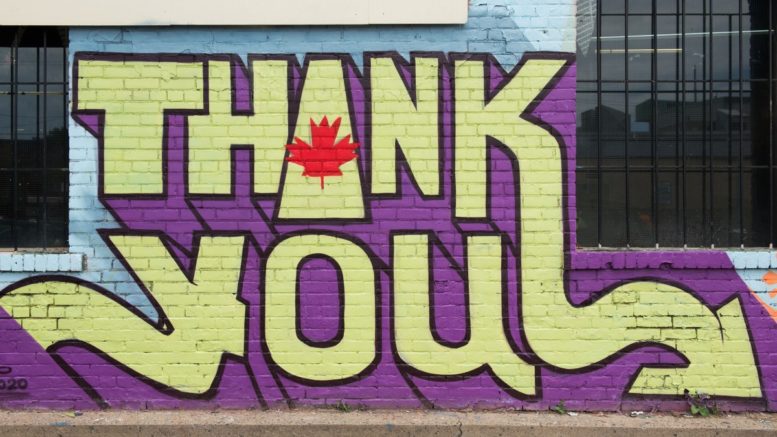While many of us were inside our homes during the summer slowly adjusting to living life in a pandemic, Toronto graffiti artist Jabari “Elicser” Elliott was outdoors creating a mural in a tribute to the extraordinary efforts of essential workers.
Elliott is one of many artists responsible for the new street art that has been popping up around Toronto. The city’s walls, buildings, and underpasses have undergone major paint jobs, as street, mural, and graffiti artists came together to spread messages of positivity all over Toronto in support of frontline workers.
“The nurses are out there, fully, getting the full brunt of it all,” said Elliott when speaking about his mural found at 1230 Dundas St. W. “The reference behind the piece…is Rosie the Riveter. Basically, they’re fighting for us again.”
For those unaware (or too young), Rosie the Riveter was an iconic representation for the women who worked in factories on the home front during the Second World War.

It’s easy to see that artists put real time, care, and creativity into these thoughtful creations over the summer, but it may come as a surprise that this street art was commissioned by the City of Toronto.
Front Line Heroes
COVID-19 related murals like Elliott’s have appeared throughout the summer as part of the city’s Front Line Heroes project. The project is meant to celebrate essential workers of all genders, backgrounds, ages, and professions during a year that turned out to be anything but normal.
The project is part of an even larger city-run program called StreetARToronto, or StART for short. StART was created in 2012 as part of Toronto’s Graffiti Management Plan. It’s been used as a way to encourage artists to spread their art, and promote the positive use of creativity while reducing graffiti vandalism.
“Because we actively listen to artists, it was clear to us that there was interest from artists in somehow, through their art, showing appreciation for the work the front line heroes were doing,” said Carolyn Taylor, the StART project manager.
Taylor is part of a surprisingly small group of five staff who work together to keep the StreetARToronto program running. The team works out of the Transportation Services Division of the City of Toronto, and they approved 15 murals by 23 artists for this Front Line Heroes project.
“They’re making the walls accessible,” Elliott acknowledged. The artist has been with StART for almost a decade. “Technically, if this whole thing wasn’t happening, we’d still be painting, but we’d be cowering and scurrying back inside. When that happens, the piece itself is affected.”
Graffiti versus street art
Graffiti is still technically illegal, as it is considered an act of vandalism. But StreetARToronto has essentially commercialized a portion of Toronto’s graffiti scene by making it legal while turning it into a business opportunity for numerous artists. The contracts can pay up to $5,000 per piece, depending on where in Toronto the street art is created, and how large it is.
While some may see this as selling out, others see it as an opportunity for struggling artists to get paid for their work.
Peru Dyer Jalea is a graffiti writer who has been with the program for many years, so he knows both the municipal and street-level aspects.
Before a mural can even get started, artists must first receive permission from building owners to use their property as a canvas. Even after that permission is obtained, finished pieces might not stay in perfect condition for long.
His Front Line Heroes piece involved painting over some existing graffiti found on the side of Pancho’s Bakery, a Latino-owned store in the Bloordale Village neighbourhood.
“Anyone who paints over [the existing graffiti] will most likely have those guys come back and paint over it again,” Jalea explained to the owners. “It’s me, coming from graffiti, and because it’s honouring front line workers, it would be in very poor taste to go over that.”
On the street, the walls don’t really “belong” to anyone. Other graffiti artists may decide to tag over an existing piece in an act of disrespect, fun, competition, or all of the above. Jalea understands that well, so he proposed his idea with those facts in mind.

Jalea’s original idea was to paint a garbage truck to honour sanitation workers, but that didn’t exactly mesh well with the idea of selling food right next to it. He change it instead to a fire truck, with the word “Gracias” on the right, in his signature style.
“My son loves fire trucks, like most kids do, and my daughter’s favourite colour was red, so I tried to incorporate that in my mural,” Jalea said. “[Firefighters] are very underpaid, doing one of the most dangerous jobs there is.”
Looking at the many pieces from the Front Line Heroes project, including the art above, it seems that the StART program has grown well beyond its initial goal of graffiti management. It’s become a collection of individuals who actively brighten up the city in tangible ways.
“There’s a lot of things that can’t be said with words that are beyond our comprehension,” said Jalea when explaining the impact of the pandemic murals on communities. “In art, we try to speak on that in a different way, and kind of bring people together, and uplift peoples’ spirits, and uplift the neighbourhood.”

